If you click on a link and make a purchase we may receive a small commission. Read our editorial policy.
The evolution of the Stan Lee cameo
The secret origins of the Stan Lee cameo
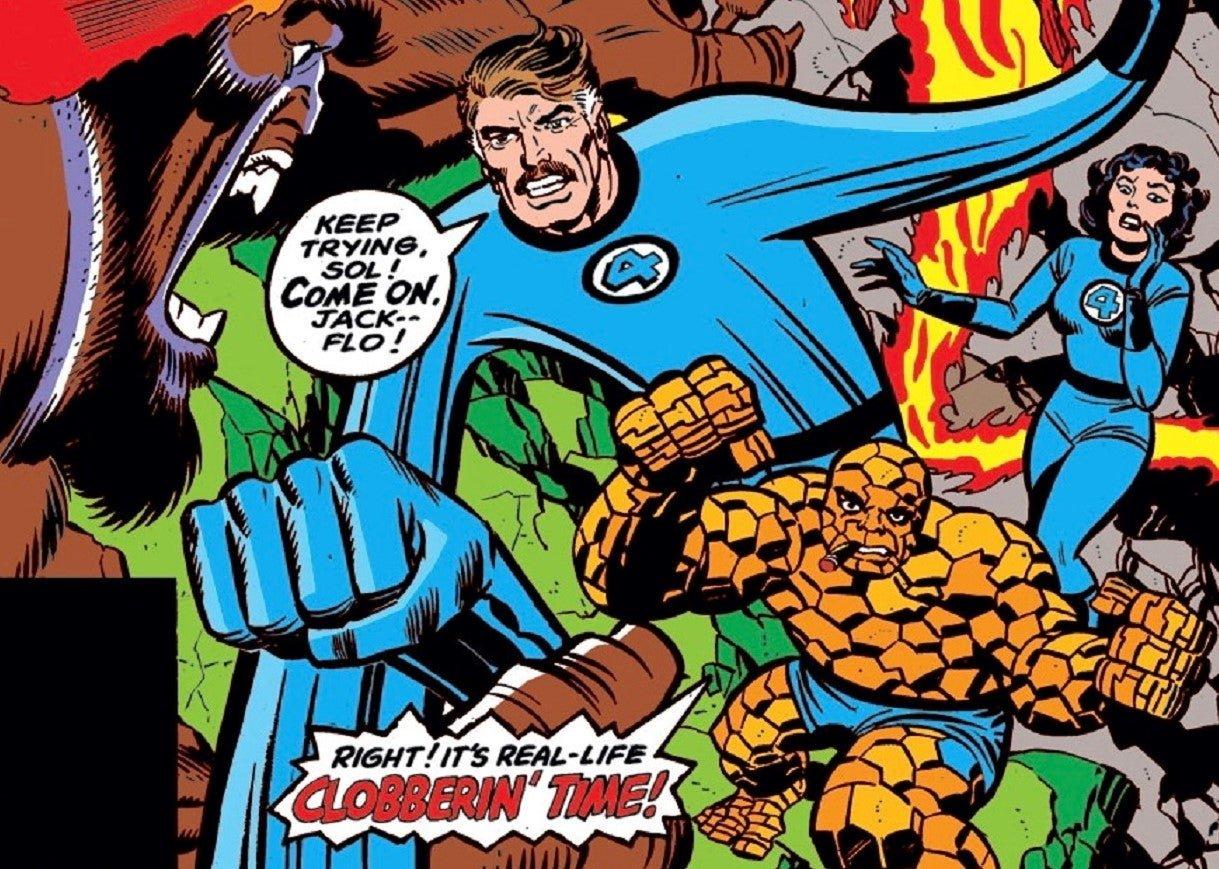
Stan the Man
Stan Lee is easily one of the most recognizable creators in the comic book industry. As one webcomic points out, even people who aren’t familiar with superheroes recognize Stan Lee by sight. In addition to co-creating Spider-Man, Iron Man, Hulk, and dozens of other Marvel Universe characters, Stan Lee is known for his beloved superhero movie cameos. But before Stan Lee cameos were a staple of the silver screen, the famous creator made frequent appearances within the comic book source material.
This article will not list every single comic cameo Stan Lee made, but it will chronicle his early appearances. From there we will explore how these early cameos changed the comic book industry, which began to put more focus on creator personalities. We will also explore how Stan Lee evolved throughout these cameos, going from a reserved businessman to the sharply dressed and flamboyant man he’s known as today.
Stan Lee meets the Vision (Marvel Mystery Comics #23)
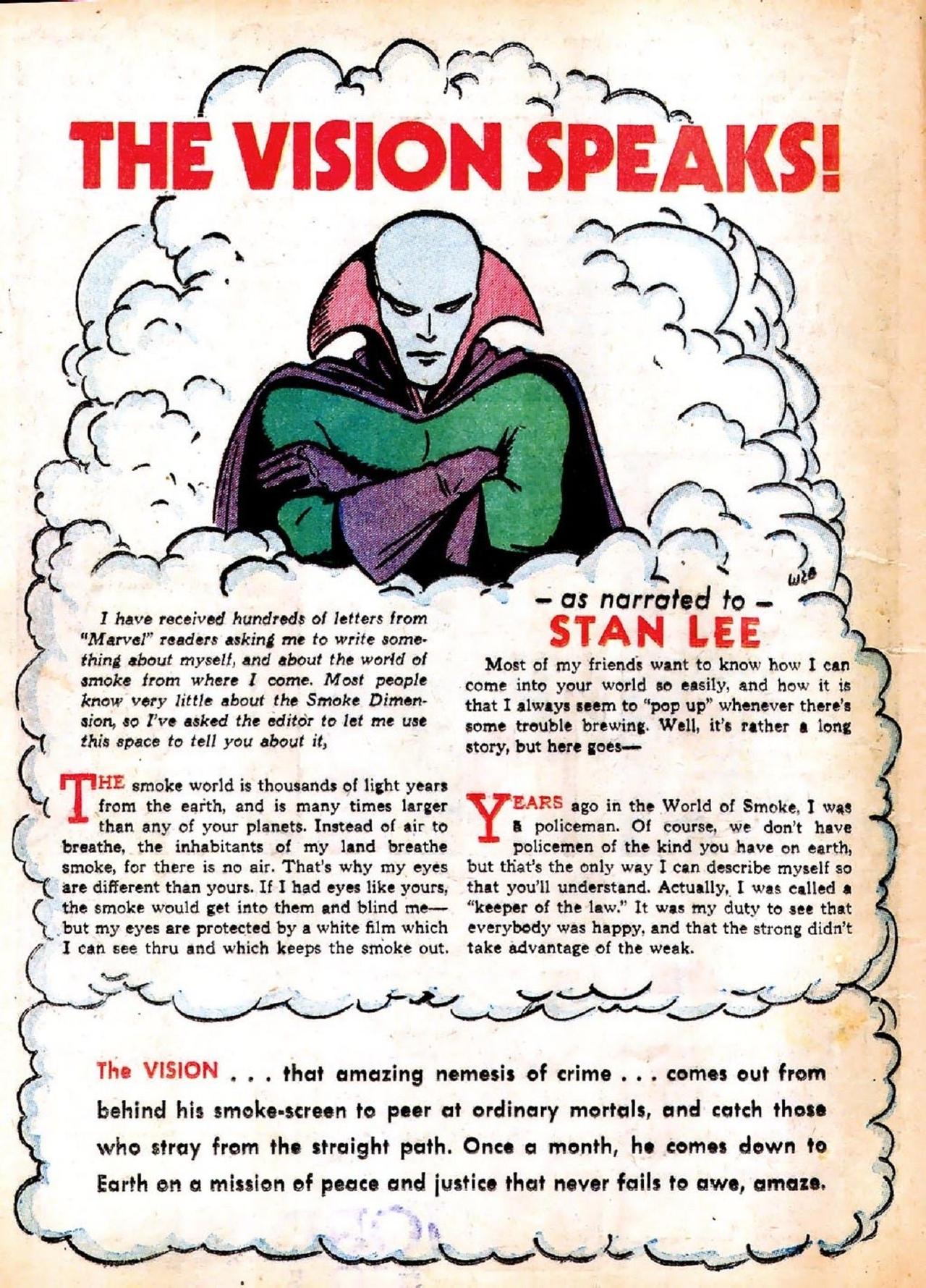
One of the interesting things about tracking Stan Lee’s cameos within the comics is that there is no clear contender for the first one. Lee’s early cameos were text pieces, or illustrated caricatures that took liberties with his appearance and role. For example, the first time Stan Lee inserted himself into a Marvel Comics story was a text piece in Marvel Mystery Comics #23 (1941) called ‘The Vision Speaks.’ The text piece is written as an in-character narrative from the Vision, a smoke-based hero who predates the android that shares his name. In his narrative, the Vision tells the readers he came to the editor of Marvel Mystery Comics with a request to tell his story. The title page features a blurb saying “as narrated by Stan Lee.” It would be hard to call this a Stan Lee cameo, but it is the first time Lee was referred to as a fictional character within the Marvel Universe.
Chatting with super-heroes (All Winners Comics #2)
Stan Lee’s next in-story appearance occurred in a text piece titled ‘Winners All; published in All Winners Comics #2 (1941). This time he was a bit more involved in the story, though it still wasn’t a fully realized cameo. The text piece uses a framing sequence where Captain America, the Human Torch, and the Sub-Mariner make an appeal to add the Destroyer and the Whizzer as regular features in All Winners Comics #2. Stan agrees with the proposal, giving him his first official piece of dialogue in a Marvel Comic.
Office hijinks (Mystic Comics #10 and Terry-Toon Comics #12)
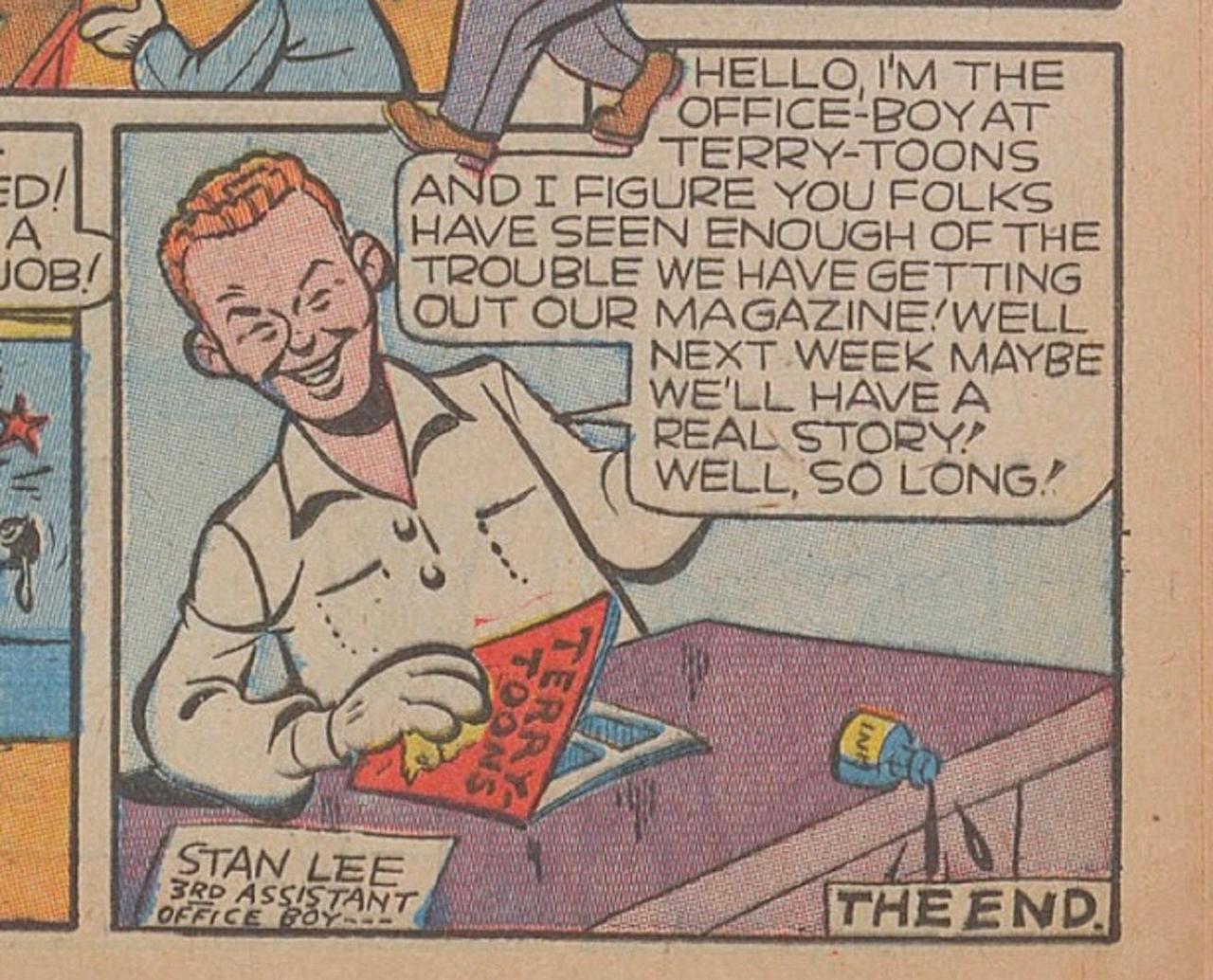
‘Story Conference’ from Mystic Comics #10 (1942) featured a man named Stanley Dee, editor of Crimely Comics, a playful homage to Timely Comics, Marvel’s ‘40s predecessor. Stanley Dee is illustrated as an older man, a far cry from the real Lee who would’ve been 19 at the time. Due to his age and name, this feels like a playful Easter egg rather than a real cameo. Stan Lee’s first illustrated appearance came in an unusual place – Terry-Toons Comics #12 (1943). Terry-Toons Comics was a funny animal book based on characters appearing in Terrytoon Studios theatrical shorts. Issue 12 contained a story called ‘The Ginch and Claude Pennygrabber’ where the toon characters break the fourth wall and argue with the comic staff about the production of their comics.
The story ends with Stan Lee, identified as a third assistant office boy, telling the readers that they’ll publish a “real story” next time. The depiction of Lee was far from accurate. For one, he looked more like Alfred E. Neuman than the charismatic creator we’re more familiar with. Despite being described as an office boy, Stan Lee had been an editor for almost two years at this point.
Stan Lee Dates a Teenager (Margie Comics #36)
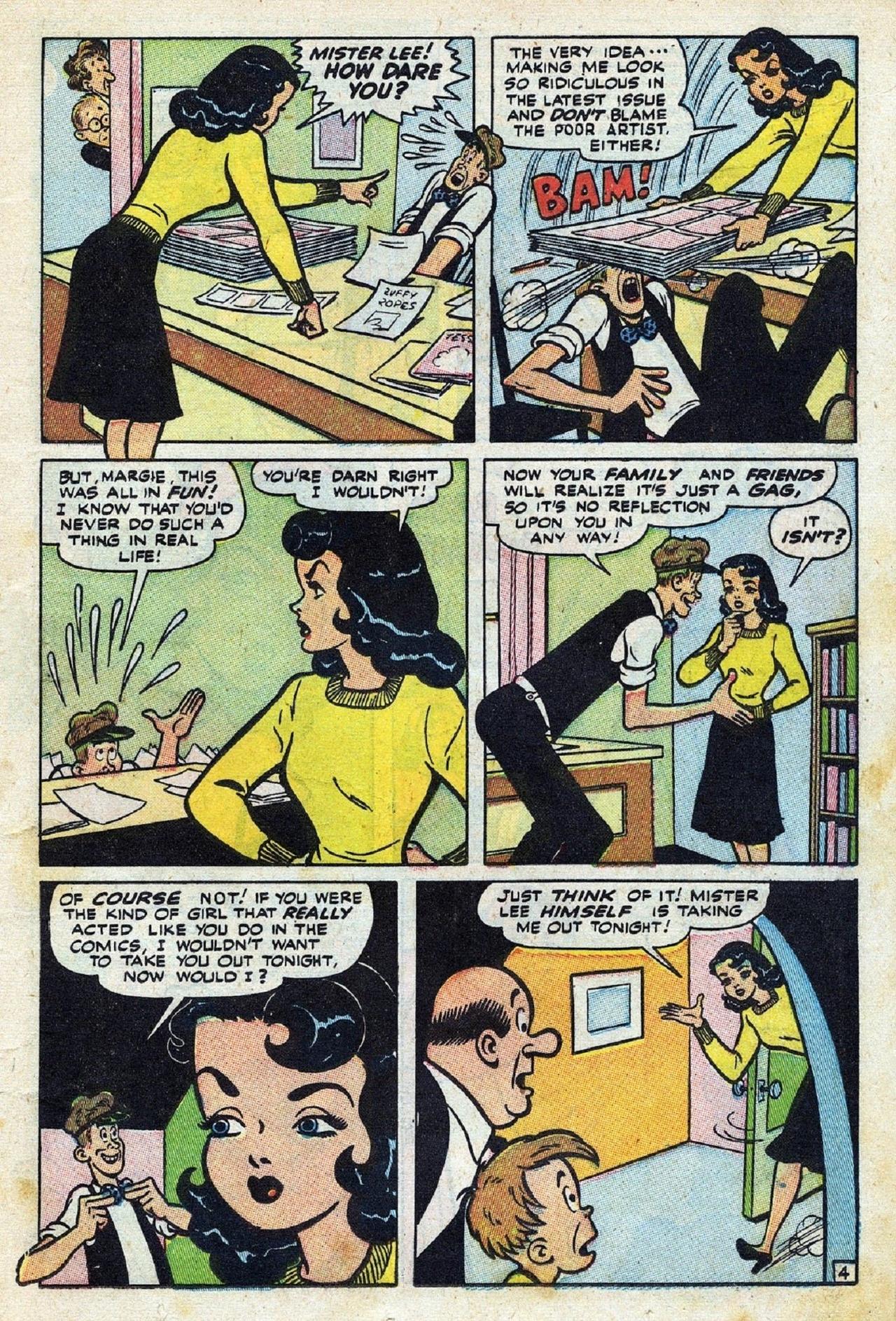
Margie Comics #36 (1947) featured the next Stan Lee cameo, and it was an unusual one. Margie was one of Timely Comics teen comedy characters, and the story ‘Margie’s Big Date’ had some fun breaking the fourth wall. Margie was mortified at how she was portrayed in her comic, so she marched to the Timely Comics office to give Stan Lee a piece of her mind.
Margie confronted Lee, who was drawn to be tall, lanky, and had the proportions of a newspaper comic strip character. Lee calmed Margie down, and in a moment that hasn’t aged well, asked the teen girl for a date. Lee took Margie to an exclusive nightclub, and was embarrassed when she asked a celebrity for an autograph. This caused Lee to abandon Margie at the venue, saying that she should look him up in a few years after she had grown up.
Cover Model (Black Rider #8)
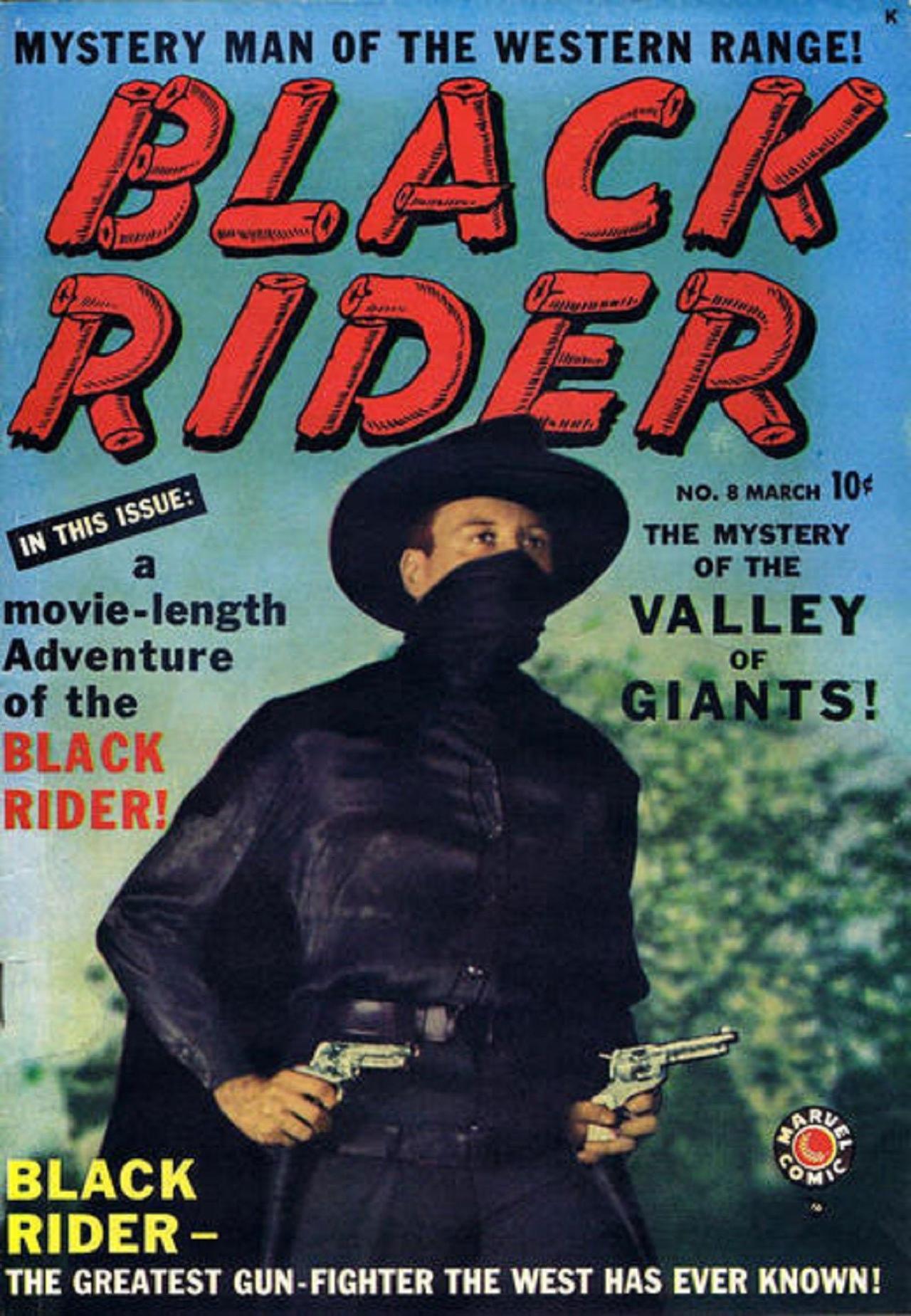
Black Rider #8 (1950) took Stan Lee cameos to the next level by using a photograph of Stan himself on the cover. Black Rider was a western adventure series, and at the time it was standard practice for cowboy comics to feature photographs on their covers. Instead of using an actor or cover model, Lee dressed up in a black ensemble, donned a dark mask, and posed holding two toy guns. It would be years before Lee would become a household name, so at the time the general public had no way of recognizing him.
Stan the Editor (Astonishing #4)
By the ‘50s Marvel was leaning into the horror genre, publishing a line of comics which gave us some more Stan Lee cameos. Astonishing #4 (1951) features a story called ‘The Nightmare’ where a comic book writer gets his story ideas from his nightmares. Stan Lee appears as the editor, assigning the writer to come up with a story for the next issue of Astonishing. Stan is illustrated as a dark-haired man, dressed in a business suit, and clean shaven. This was the most accurate illustration of Lee at the time, as opposed to the exaggerated figure we saw in Terry-Toons Comics and Margie, but he was still a far cry from the flamboyant Lee we’re more familiar with. That persona would come later.
Stan and the Freelance Vampire (Adventures Into Terror #5)
Adventures into Terror #5 (1951) featured an older advertising editor named Lee Stanton, and while he didn’t physically resemble Stan, he’s still worth noting. Stan Lee appeared as himself in Mystery Tales #24 (1954), paying one of his horror writers, unaware that the scribe was secretly a vampire. It’s amusing to note that Lee paid the writer directly, handing him a wad of cash, something that is unheard of in the modern comic book industry.
Stan and Dan meet Irma (My Friend Irma #41)
My Friend Irma #41 (1953) featured the title character confronting Stan Lee and artist Dan DeCarlo about the way they were depicting her in her comic. My Friend Irma was based on a popular radio show that eventually spawned multiple films, a television series, and a newspaper comic strip. Stan Lee is illustrated with exaggerated proportions, depicted as a lanky brunette.
Stan Lee vs. Fredric Wertham (Suspense #29)
Suspense #29 (1953) is one of the most interesting Stan Lee cameos from this era, as it pits him against a caricature of the infamous psychiatrist Fredric Wertham. Throughout the early ‘50s Wertham had been making waves in the comic book industry by trying to convince the public that the periodicals lead to a rise in juvenile delinquency and sexual depravity. ‘The Raving Maniac’ (published in Suspense #29) gave Lee a chance to answer to these charges.
The story features a man, obviously a parody of Wertham, storming into Lee’s office and demanding that he cease publishing horror comics. Lee angrily tells the man that the escapism found in comics is important to the people of the world during these uncertain times. The man is dragged out of Lee’s office by a pair of orderlies, who reveal that he’s an escaped mental patient. Lee then goes home, where he’s greeted by his wife Joan and daughter JC, making their comic debut.
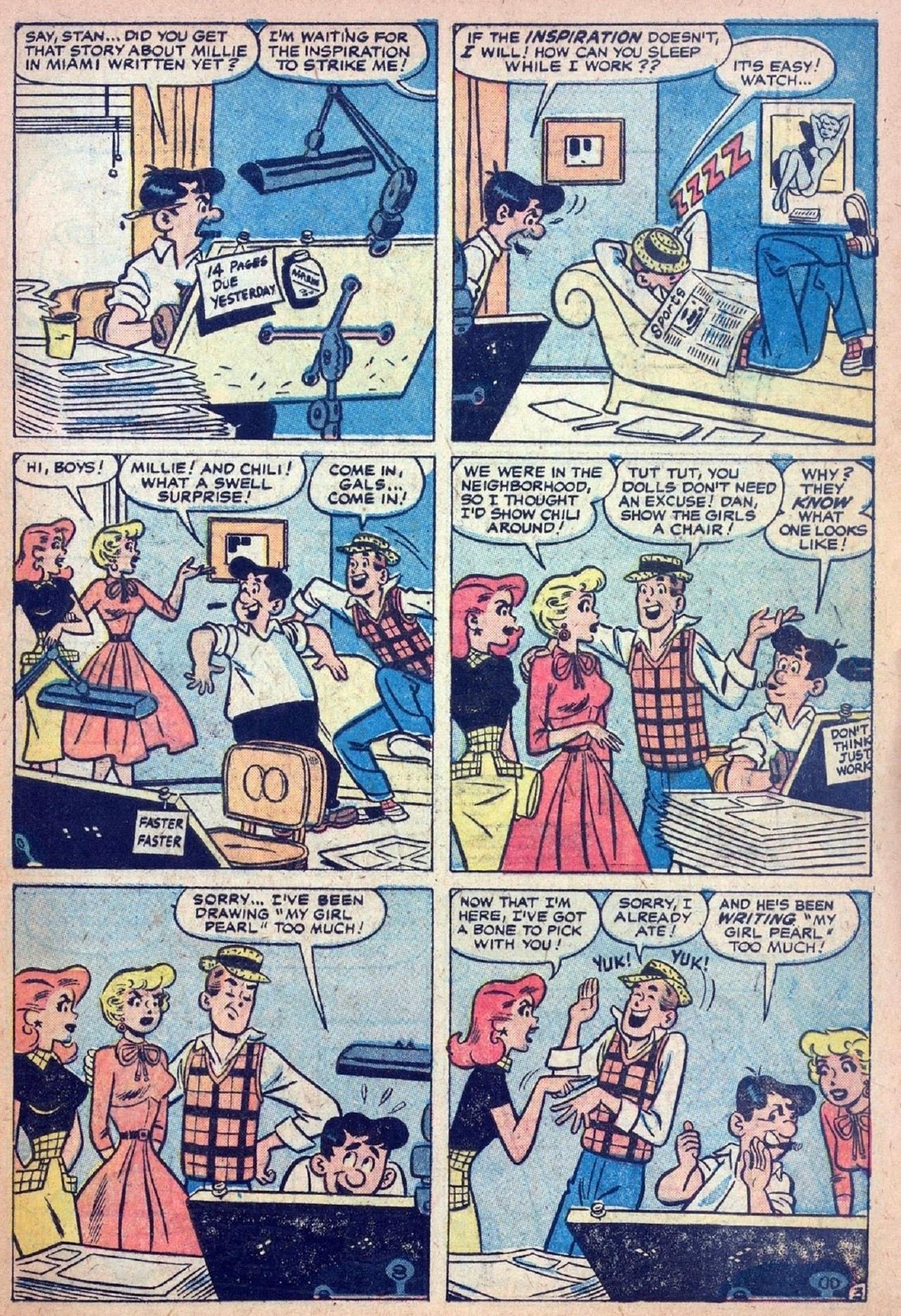
A model and a ghost (Millie the Model #77 And Homer the Happy Ghost #18)
Millie Collins and her rival Chili Storm visit Stan Lee and Don DeCarlo in Millie the Model #77 (1956). The premise is somewhat meta, establishing that Millie’s comics exist in her fictional universe as licensed stories about her life. DeCarlo drew this issue, and thus, Stan’s character design matches the one seen three years earlier in My Friend Irma. Millie the Model #77 is historical because it might be Stan Lee’s first illustrated appearance in Marvel’s 616 continuity. One could argue that Lee’s cameo in Margie #36 holds that distinction, since Margie Murphy appeared alongside other Marvel characters in Marvel Valentine Special #1 (1997). However, the canon status of that story is vague, leaving Margie’s 616 status uncertain. On the other hand, Millie Collins is an established presence in 616 continuity, so this could be considered Stan Lee’s first true Marvel Universe appearance. The idea of an angry comic protagonist visiting Stan and Dan was recycled for a third time in Homer The Happy Ghost #18 (1957) when the creative duo encountered the ghoulish Casper knockoff.
Coming of the editor (Tales to Astonish #20 and Patsy and Hedy #78)
Lee next appeared in Tales to Astonish #20 (1961). Although he was unnamed, his character was the editor for Tales of Suspense and Strange Tales, two of the comics Marvel was publishing at the time. Patsy and Hedy #78 (1961) used a similar premise as Lee’s Millie the Model appearance, with Patsy Walker’s rival Hedy Wolfe traveling to New York City to meet Stan Lee and artist Al Hartley. Like Millie the Model, Patsy and Hedy played with the meta concept that their comics existed in their universe as authorized stories about their adventures. Interestingly, Defenders #89 (1980) expanded on this premise, establishing that Patsy Walker’s comics had made her a childhood star.
Pinup star (Millie the Model Annual #1)
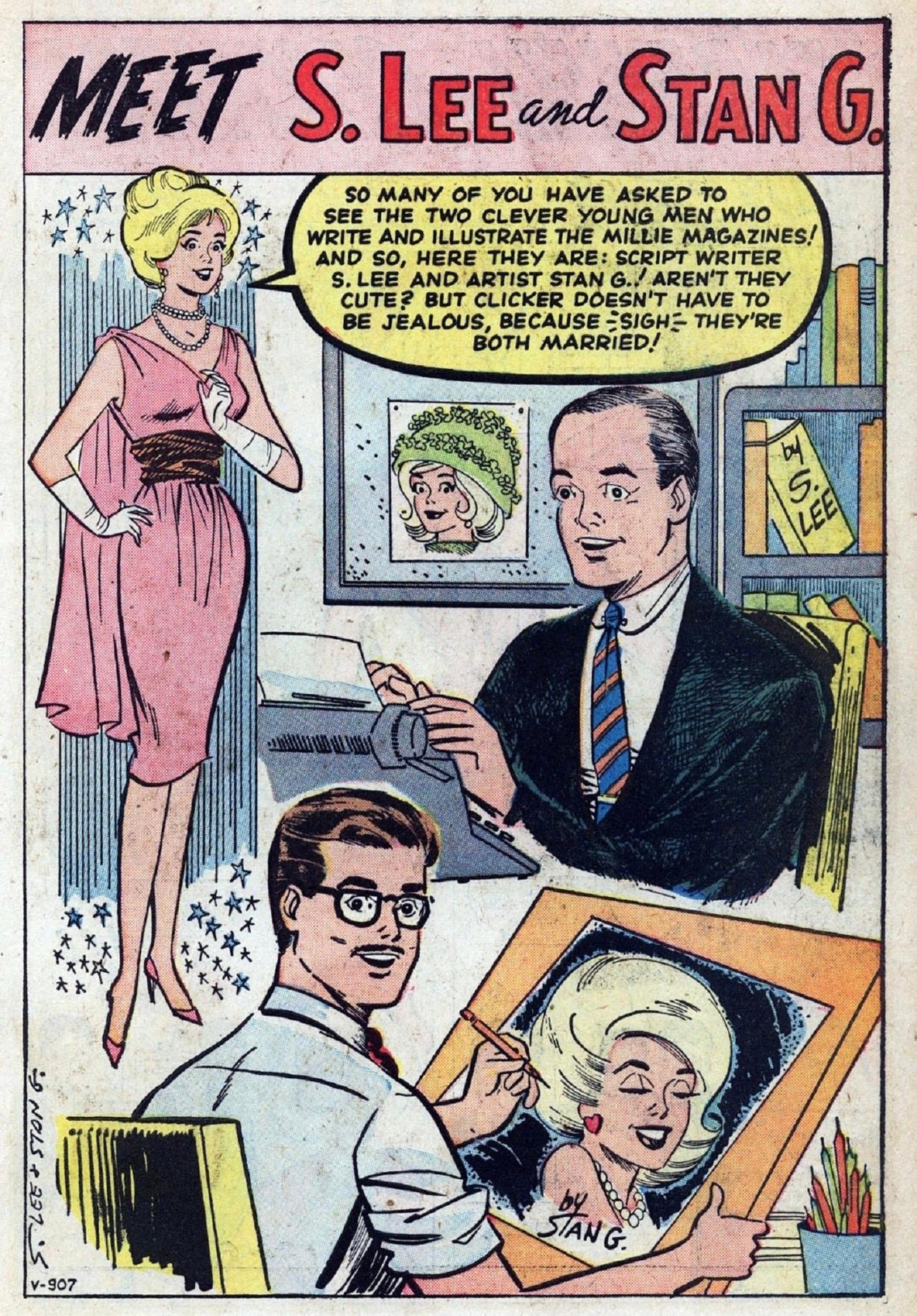
Stan Lee and artist Stan Goldberg were featured in a full-page pinup in Millie the Model Annual #1 (1962). The illustration of Stan is the most accurate one to date, matching most of the photographs of him from this time period. Millie states that many letter writers have requested to see an image of the creative duo, a claim that is somewhat dubious. Millie wistfully expresses regret that both men are married, which means that Stan wrote a comic where a supermodel finds herself attracted to him.
Hiding his face
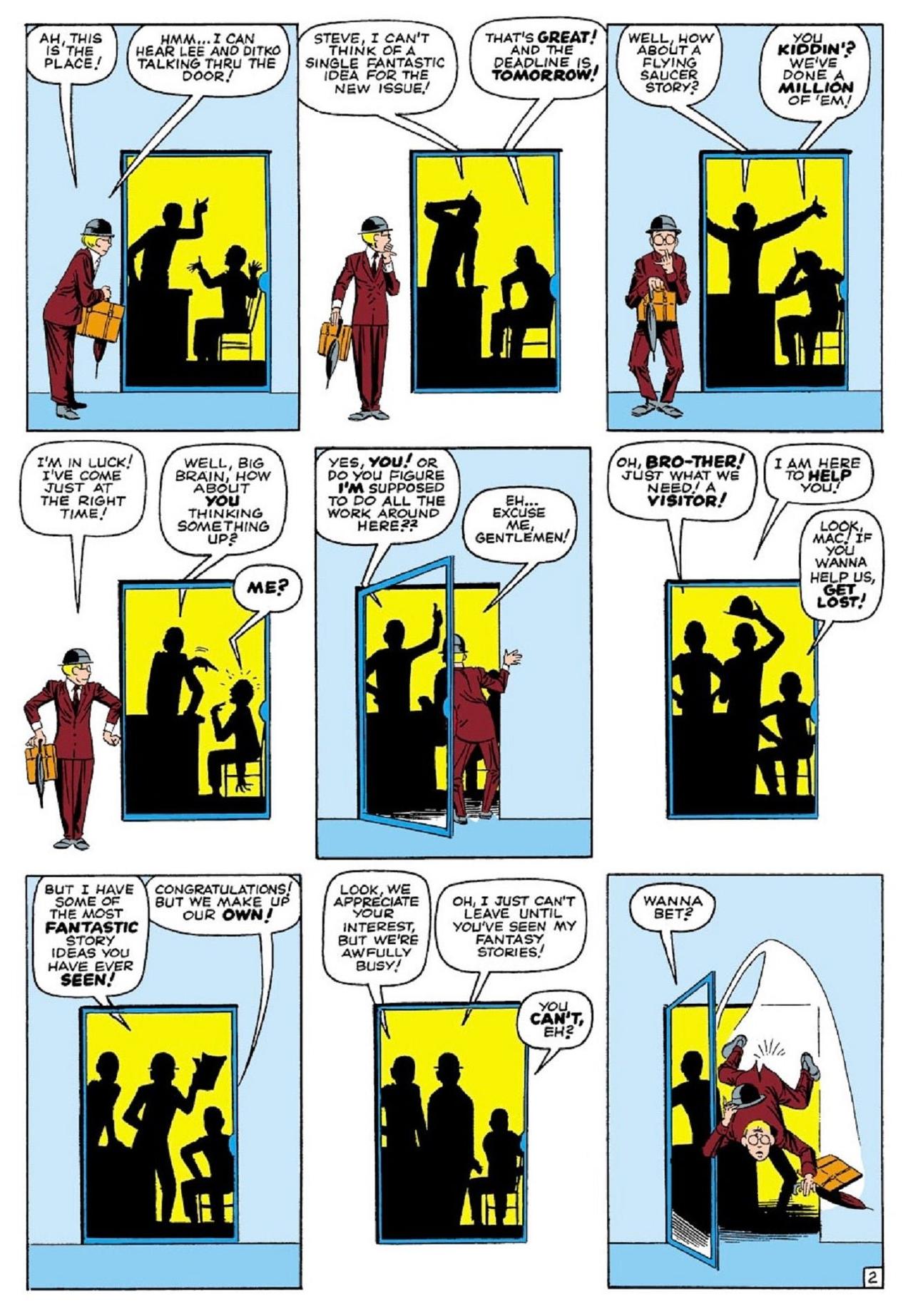
Amazing Adult Fantasy #12 (1962) foreshadowed the way Stan Lee cameos would be depicted during the early days of the Marvel superhero boom. A man from the 5th Dimension tries to pitch some stories to Stan Lee and Steve Ditko, but the creative duo throw him out of the office, unaware of his true origins. Readers are never given a good look at Stan and Steve, who are depicted as silhouettes the entire time. Tales of Suspense #33 (1962) used a similar approach, covering Stan’s face throughout the entire story as a supernatural being pitched a story to the editor.
Stan’s face was once again covered in shadow in Kid Colt Outlaw #107 (1962), which had the editor mysteriously receiving a piece of paper chronicling a tale of aliens battling cowboys during the old west. When Stan Lee and Al Hartley appeared in Patsy and Hedy #85 (1962) readers only saw the back of their heads, despite the fact that their previous appearance in the title had shown their faces. What a difference a year makes. It would be hard to convince someone that an infamous showman like Stan Lee was getting shy, so perhaps it can be theorized that obscuring his features was meant to add some mystique to the men behind the comics. This became the standard operating procedure as Stan Lee and Marvel began the next exciting phase of their history.
Into the Marvel Age (Fantastic Four #10)
During the superhero boom of the ‘60s, Stan Lee tried to build Marvel’s brand by making the creators behind the comics stars as well. It’s easy to forget, but during the early years of the comic industry creators were seldomly credited, and were seen as mostly interchangeable. Stan Lee really pushed the idea of the Marvel bullpen being personalities, hoping it would make readers feel more connected to the comics. In our present-day comic creators are big names. Their names become big draws for conventions, and some have made international news. While these early Marvel cameos aren’t completely responsible for the current status quo, they played a big role in building the relationships between creators and their readers.
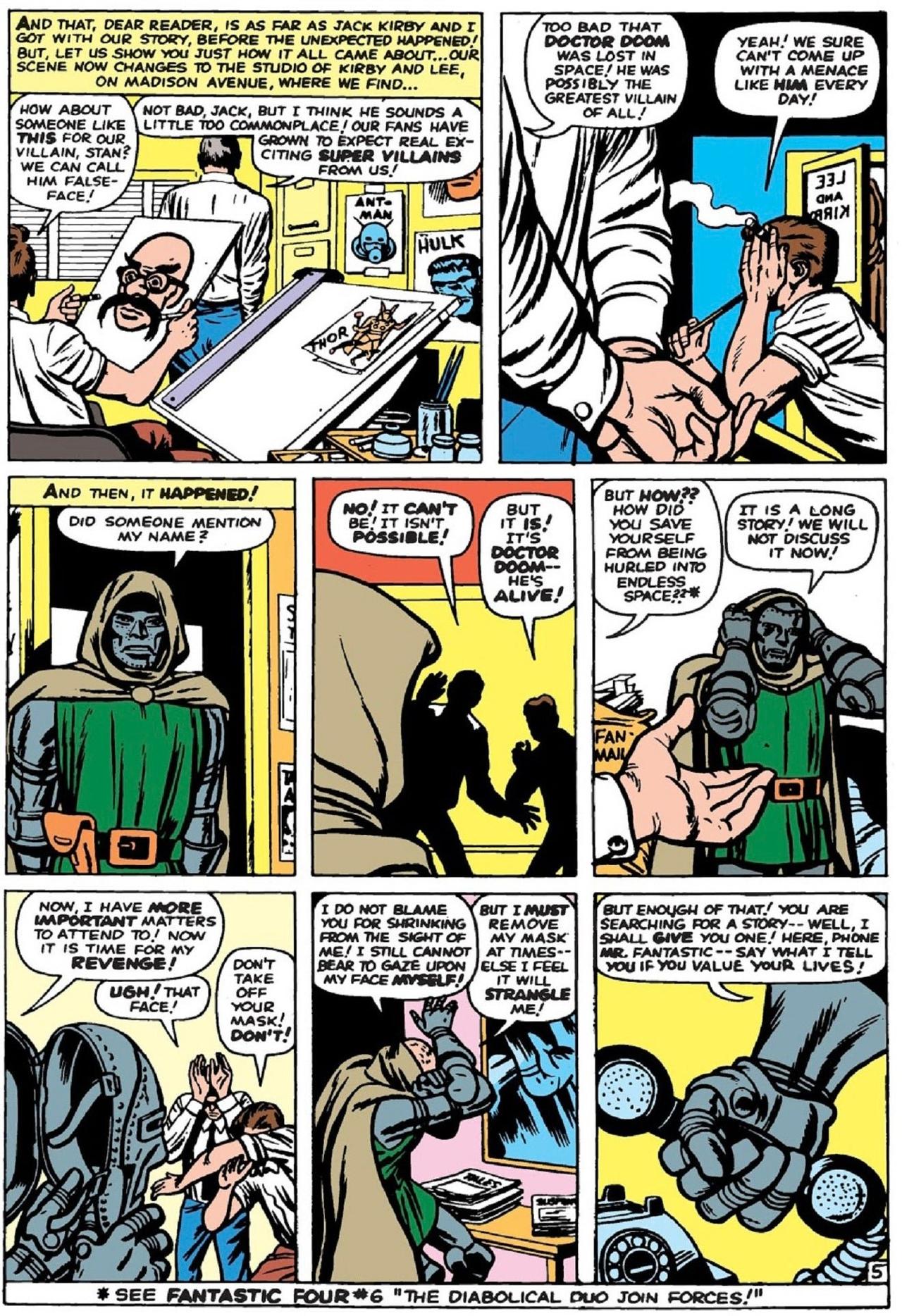
Fantastic Four #10 (1962) took some cues from Stan Lee’s appearances in Millie the Model and Patsy and Hedy. Like Millie Collins and Patsy Walker, the Fantastic Four had authorized Marvel to publish comic book version of their adventures. In other words, Marvel Comics exist in the Marvel Universe. Fantastic Four #10 ran with this idea as Doctor Doom walked into Stan Lee and Jack Kirby’s office, threatening them if they didn’t summon Reed Richards. Lee and Kirby’s faces were unseen throughout the story, constantly being obscured by shadows or their own hands.
Around the Marvel Universe
The practice of obscuring Lee’s face was abandoned in Strange Tales #123 (1964) when he and artist Carl Burgos watched the Human Torch and the Thing battle the Beetle. Amazing Spider-Man Annual #1 (1964) began a new trend, where Marvel annuals would feature comedic behind-the-scenes backup stories featuring Stan Lee and the Marvel bullpen’s creative process. Lee’s bombastic personality began to emerge in these stories, but he was still depicted as a clean shaved man in a business suit. Sgt. Fury and his Howling Commandos #22 (1965), a miliary comic set during World War II, featured a younger Lee serving in the Army alongside series artist Dick Ayers. This was a nod to Lee and Ayers’ real life military service during World War II. The two are briefly seen again in Sgt. Fury and his Howling Commandos #1 (1965).
Stan the wedding crasher (Fantastic Four Annual #3)
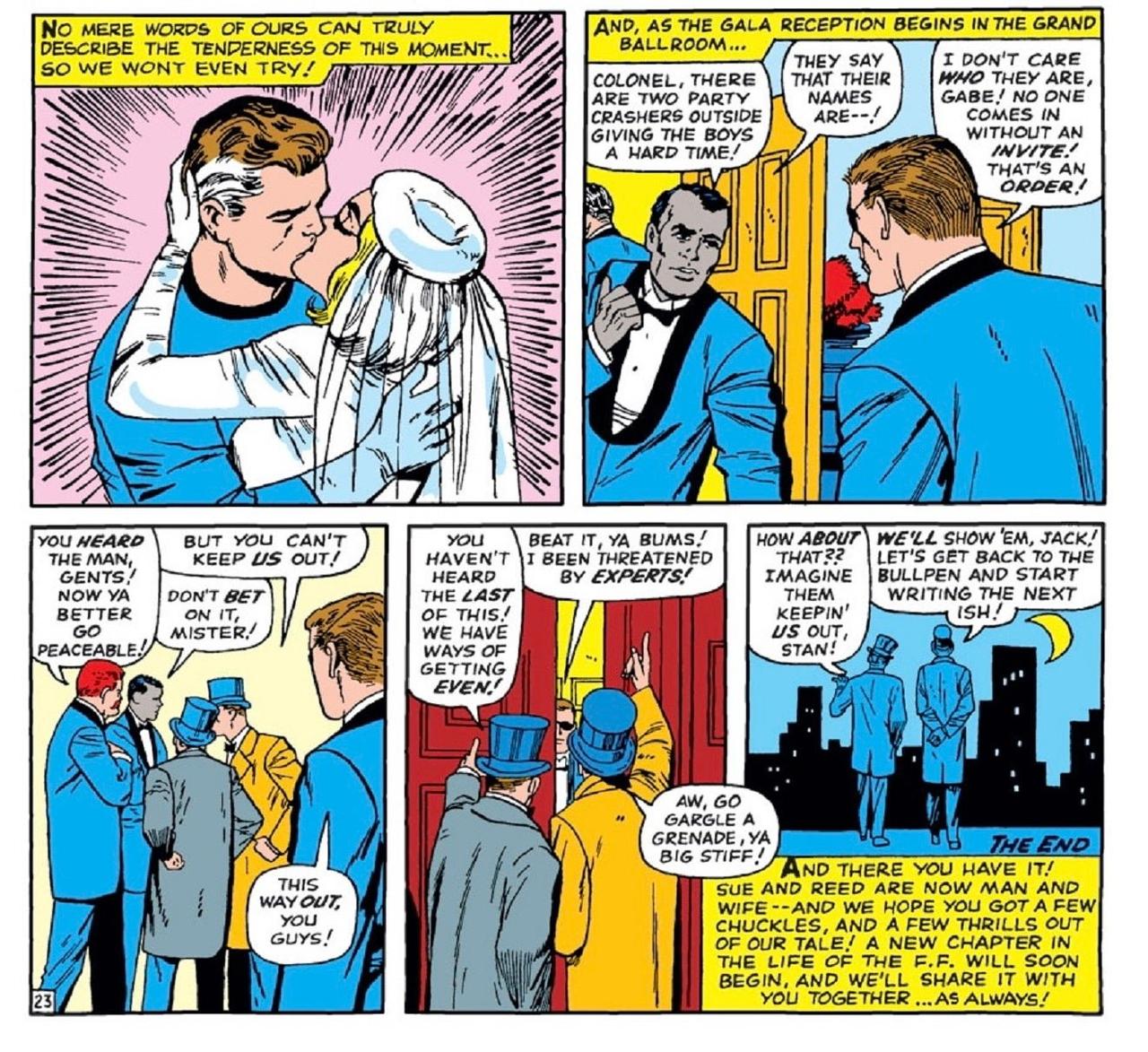
One of Stan Lee and Jack Kirby’s most famous cameos occurred in Fantastic Four Annual #3 (1965). The giant-sized annual featured the long-awaited wedding of Reed Richards and Sue Storm, and guest-starred almost every major character from Marvel’s publishing line. The story famously ends with Stan Lee and Jack Kirby being ejected from the wedding by Gabe Jones and Dum Dum Dugan, who accuse them of being party crashers. I suppose Jones and Dugan didn’t recognize the man they served alongside during World War II. Once again, Stan and Jack’s faces aren’t seen.
Stan pulls back the curtain
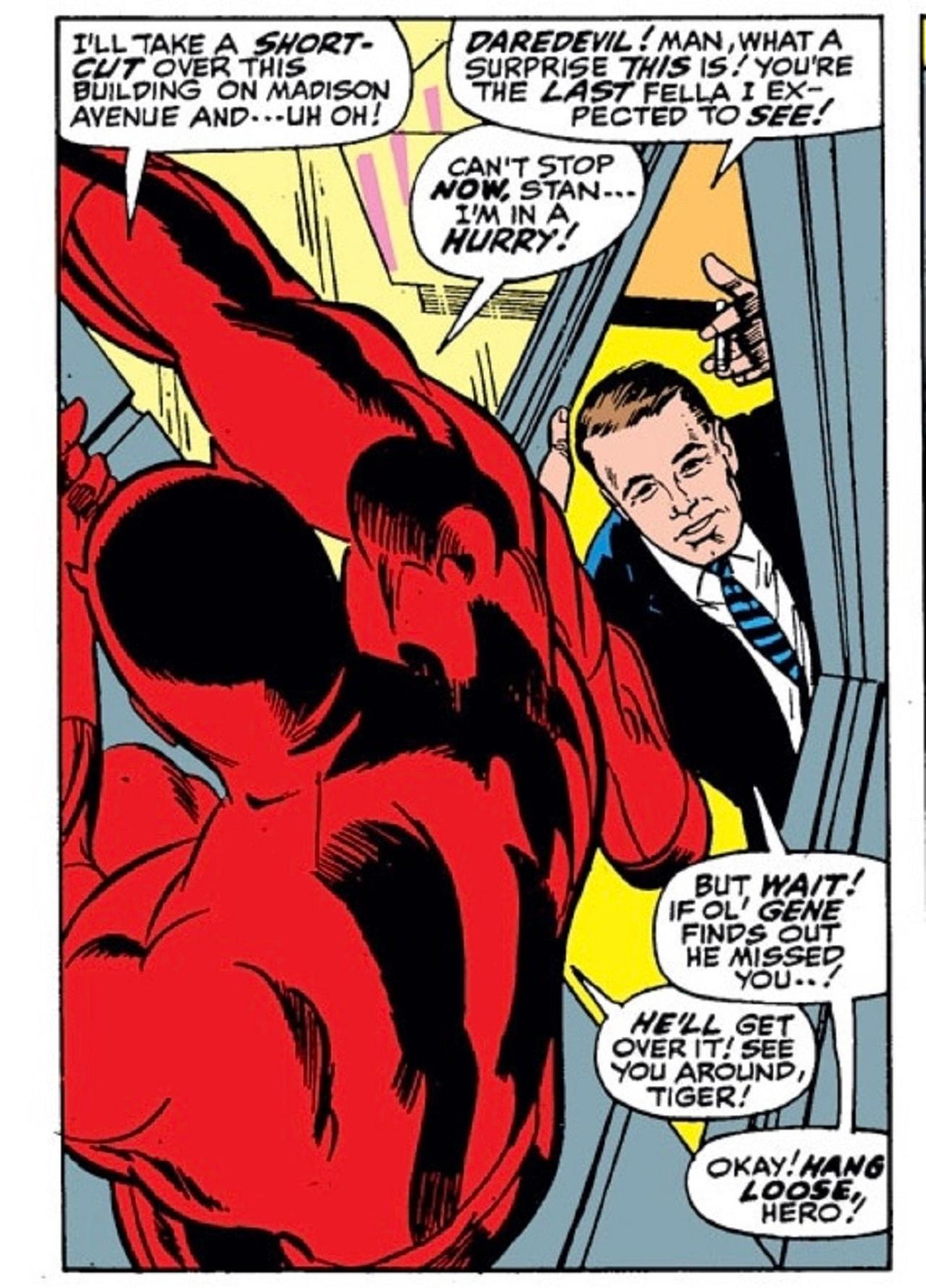
By Daredevil #29 (1967) the practice of obscuring Stan’s face was dropped completely, as the creator spotted Daredevil from his office window. Daredevil Annual #1 (1967) and Fantastic Four Annual #5 (1967) were both released shortly after, and each contained a backup story similar to the one from Amazing Spider-Man Annual #1, telling an exaggerated account of how the Marvel bullpen produces comics. This was a far cry from the straightlaced Stan Lee who was seen in his ‘50ss cameos. Now he was a colorful personality, building an established brand off of himself and his Marvel collaborators. However, he still lacked his flamboyant leisure suit, mustache, and iconic sunglasses.
Creating the Stan Lee look
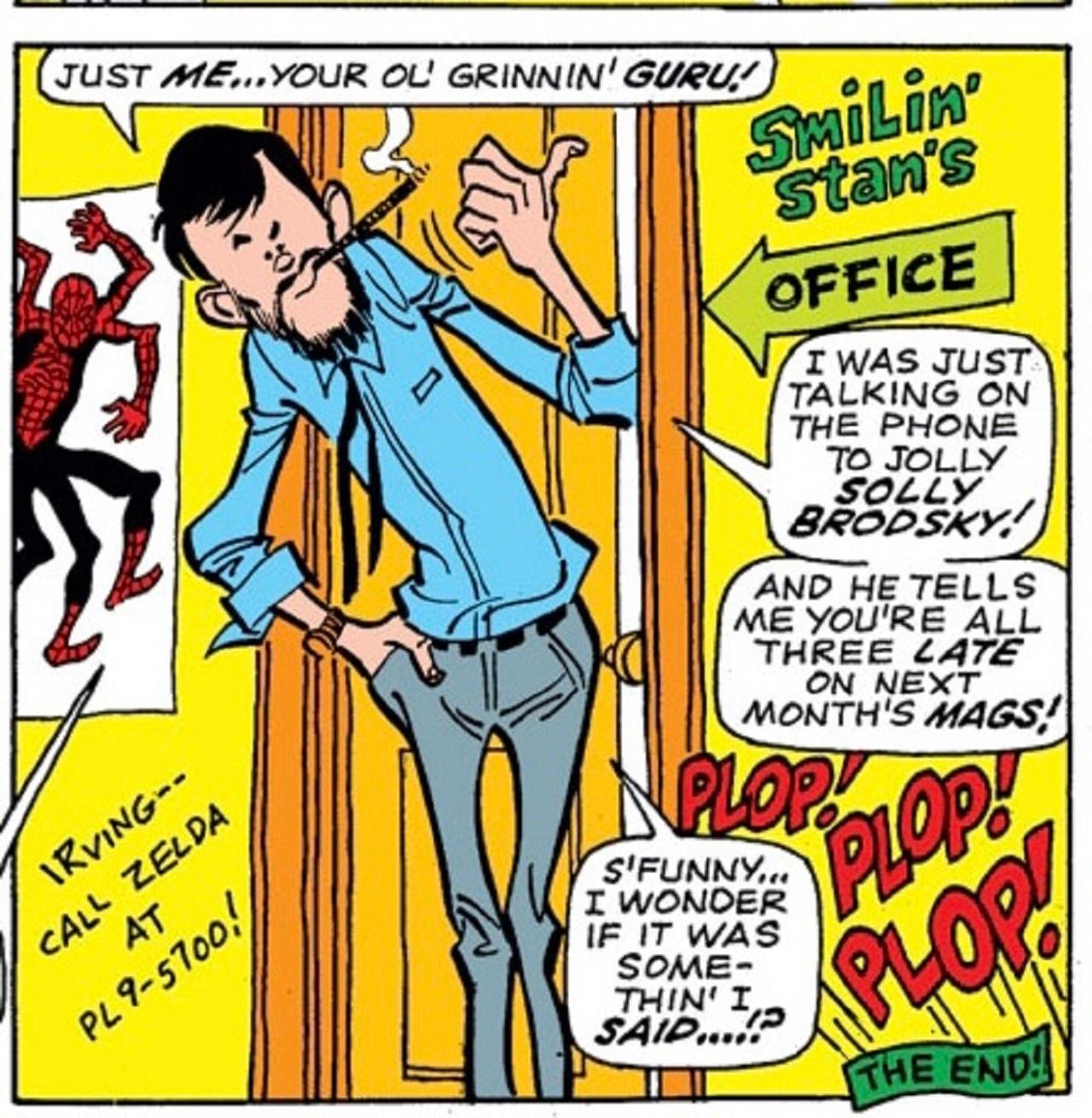
From this point the Stan Lee cameos become too frequent to fully chronicle within this space, but we’ll hit on the major changes in his appearance which culminated with Stan finally being depicted in his iconic look. Avengers Annual #2 (1968) featured another tongue in cheek look at how Marvel Comics are created, and Stan was illustrated with a beard for the first time. Chamber of Darkness #2 (1969) depicted Stan giving the opening narration to a horror tale, and by now he had shed his business suit for an odd ensemble that was still somewhat formal.
When Stan Lee hosted a roast to commemorate Sgt. Fury and his Howling Commandos #100 (1972) he was dressed in what could be described as a leisure suit for the first time. His hair was now colored grey, bringing him one step closer to his iconic look. In Uncanny X-Men #98 (1976) Stan Lee and Jack Kirby observe Jean Grey kissing Scott Summers, and remarked about how that never happened during their time on the title. It was a fun commentary on the changing dynamics when it came to superhero romances, but it's also notable because Stan had shaved his beard, but had kept his mustache. Now all that was missing were the sunglasses.
We would be remiss if we didn’t mention What If #11 (1978), a fun story where the ‘60s Marvel bullpen are given the powers of the Fantastic Four. Stan Lee is given the powers of Mr. Fantastic, longtime staffer Sol Brodsky was given the powers of the Human Torch, Jack Kirby transformed into the Thing, and executive assistant Flo Steinberg was granted the powers of the Invisible Girl. The story is an underrated classic with art by Jack Kirby, making it a love letter to ‘60s era Marvel.
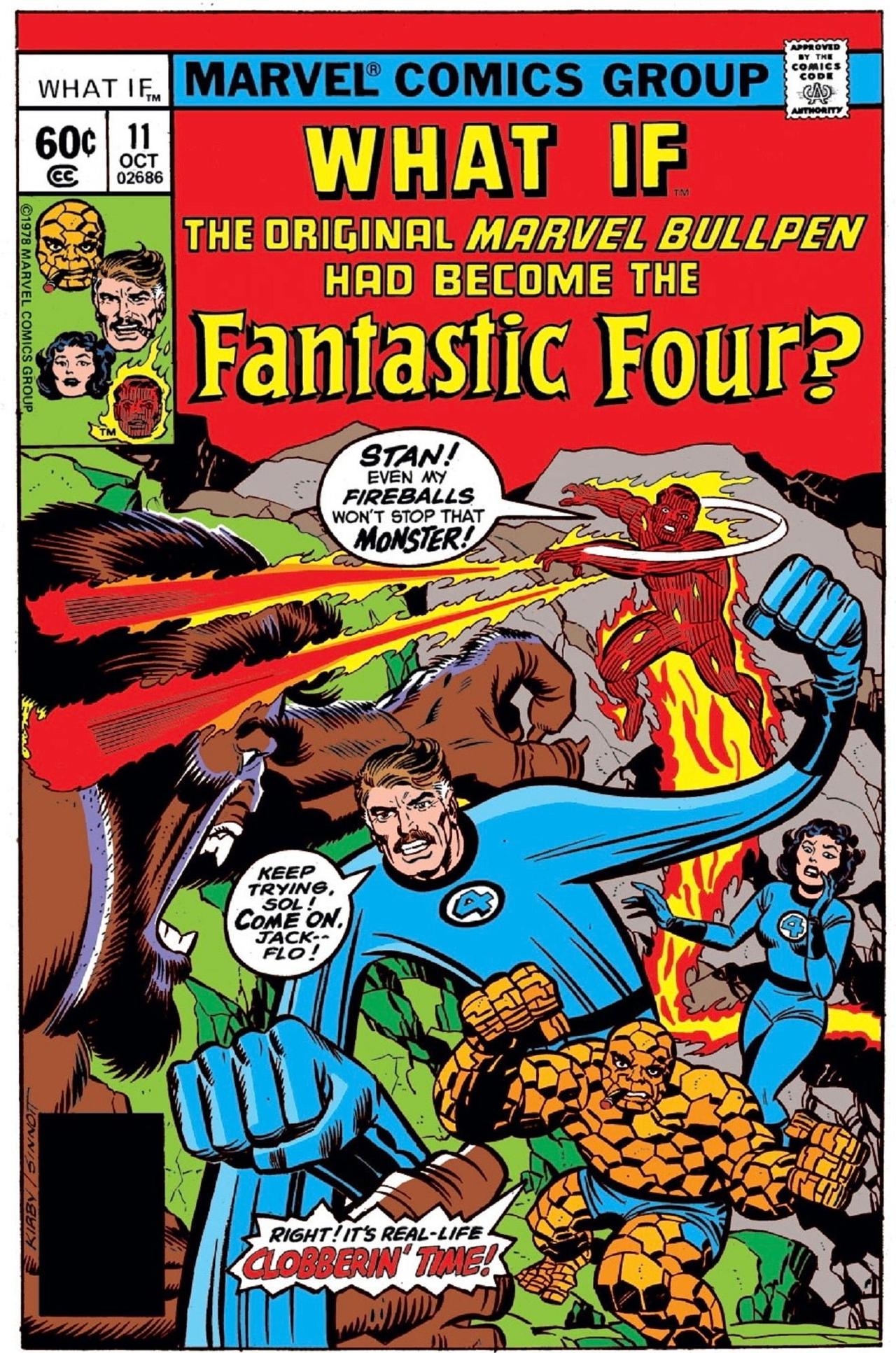
It also underscored the fact that Marvel had succeeded in making their creators into personalities the fans recognized. This was more than a cameo, Stan Lee and the gang were headlining an entire issue, something that would’ve been unheard of two decades earlier. Comic book creators were no longer anonymous writers and artists, and the evolving Stan Lee cameo played a big part in changing that.
Marvel Team-Up #74 (1978) was released on the same day as What If #11, and it completed the evolution of the Stan Lee cameo by illustrating the famed creator with his sunglasses for the first time. The story featured Spider-Man teaming up with the cast of Saturday Night Live. Stan Lee was the host for that week’s episode, and he was seen giving a high energy opening monologue with his grey temples, leisure suit, mustache, and sunglasses. For the first time he looked like the Stan Lee that has been burned into the consciousness of our modern day pop culture. Incidentally, this story has never been reprinted due to rights issues involving the likenesses of the original Saturday Night Live cast.
From comic cameos to Marvelous movies
As the Marvel heroes found their way to television and film, it was only natural that the Stan Lee cameos would come along with them. The 1989 television movie The Trial of the Incredible Hulk featured Stan Lee as a jury foreman in a dream sequence. According to an interview with Television Academy, Lee enjoyed the experience, but he was disappointed that he didn’t get to do his own stunts. After his appearances in Bryan Singer’s X-Men (2000) and Sam Raimi’s Spider-Man (2002), Stan Lee cameos became a regular part of Marvel superhero movies.
The cameos extended to theme parks, like the 2012 refurbished version of Universal Studios’ Amazing Spider-Man ride. Stan Lee even transcended universes, making a fun animated cameo in Teen Titans Go! To The Movies (2018). By the time Stan Lee passed away on November 12, 2018, he had appeared in every Marvel Cinematic Universe movie. His pre-filmed appearance in the Russo Brother’s Avengers: Endgame (2019) would be his final cameo in a superhero movie. After his death, Marvel Studios found other ways to pay homage to him, such as license plates numbers spelling out his birthday in WandaVision (2021) and Spider-Man: No Way Home (2021). Marvel Studios recently struck a deal with Stan Lee Universe, which allows them to use Lee’s likeness for future projects, ensuring that the Stan Lee cameo has a long future ahead.
These cameos introduced Stan to a new generation of fans, ensuring that he would remain a household name for years to come. None of this would have happened without these early comic cameos. It’s been an incredible journey for Stan Lee cameos, from the red-headed office assistant in Terry-Toons Comics, to an angry hippie in Avengers: Endgame. When Stan Lee began these cameos, he did with the hope that people reading the comics would look beyond the characters, and get to know the creators. If you’re on this website reading this article, I think it’s safe to say he succeeded.
Follow Popverse for upcoming event coverage and news
Find out how we conduct our review by reading our review policy
Let Popverse be your tour guide through the wilderness of pop culture
Sign in and let us help you find your new favorite thing.
















Comments
Want to join the discussion? Please activate your account first.
Visit Reedpop ID if you need to resend the confirmation email.